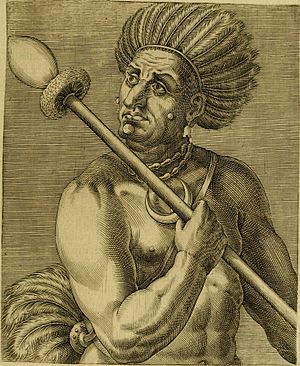Cunhambebe facts for kids

Cunhambebe (pronounced more like Quonambec in his native Tupi language) was an important Indigenous Brazilian chief. He led the Tupinambá tribe. This tribe lived in the coastal area between today's Cabo Frio (in Rio de Janeiro) and Bertioga (in São Paulo). His village was in a place called Iperoig, which is now near Ubatuba.
Cunhambebe: A Strong Leader and Warrior
Cunhambebe was a very important leader. He was the main chief of the Tamoyo Confederation. This was a strong group of native tribes who lived along the coast. They formed an alliance to fight against the Portuguese colonists.
The Tamoyo Confederation fought many battles against the Portuguese. This war lasted until a peace treaty was signed in 1567. The native tribes also teamed up with French invaders. These French forces were led by Nicolas Durand de Villegaignon. This historical event is known as the France Antarctique.

A German soldier named Hans Staden was captured by Cunhambebe's father. This happened between 1554 and 1557. The Tupinambá were known as fierce warriors. Hans Staden wrote about how he almost didn't make it out alive from their village.
The war led by the Tamoyo Confederation made it hard for the Portuguese to settle in Brazil. So, two Portuguese priests decided to try and make peace. These priests were Manoel da Nóbrega and José de Anchieta. They had started the city of São Paulo dos Campos de Piratininga, which is now the huge city of São Paulo.
The priests took a big risk by visiting Cunhambebe's village. At first, they were not trusted. But Anchieta spoke the Tupi language very well. Because of this, their lives were spared.
Anchieta was able to make a peace treaty. Cunhambebe and the Tupinambás respected this agreement. However, the peace ended later. A Portuguese knight named D. Estácio de Sá led an attack. He wanted to force the French invaders out. The Tamoyo tribes then helped the French. They felt the Portuguese had betrayed them. Also, the Temimino tribes, who were their old enemies, fought with the Portuguese.
Cunhambebe's Death
Cunhambebe died from a serious illness called bubonic plague. This happened soon after Villegaignon's French ships arrived. They came to the Guanabara Bay in Rio de Janeiro. His death was before the Tamoyo tribes were almost completely defeated. This defeat happened towards the end of the 1500s.
See also
 In Spanish: Cunhambebe para niños
In Spanish: Cunhambebe para niños

